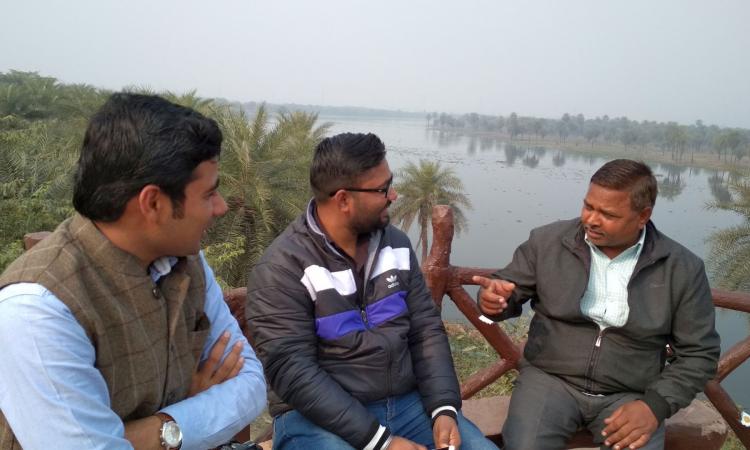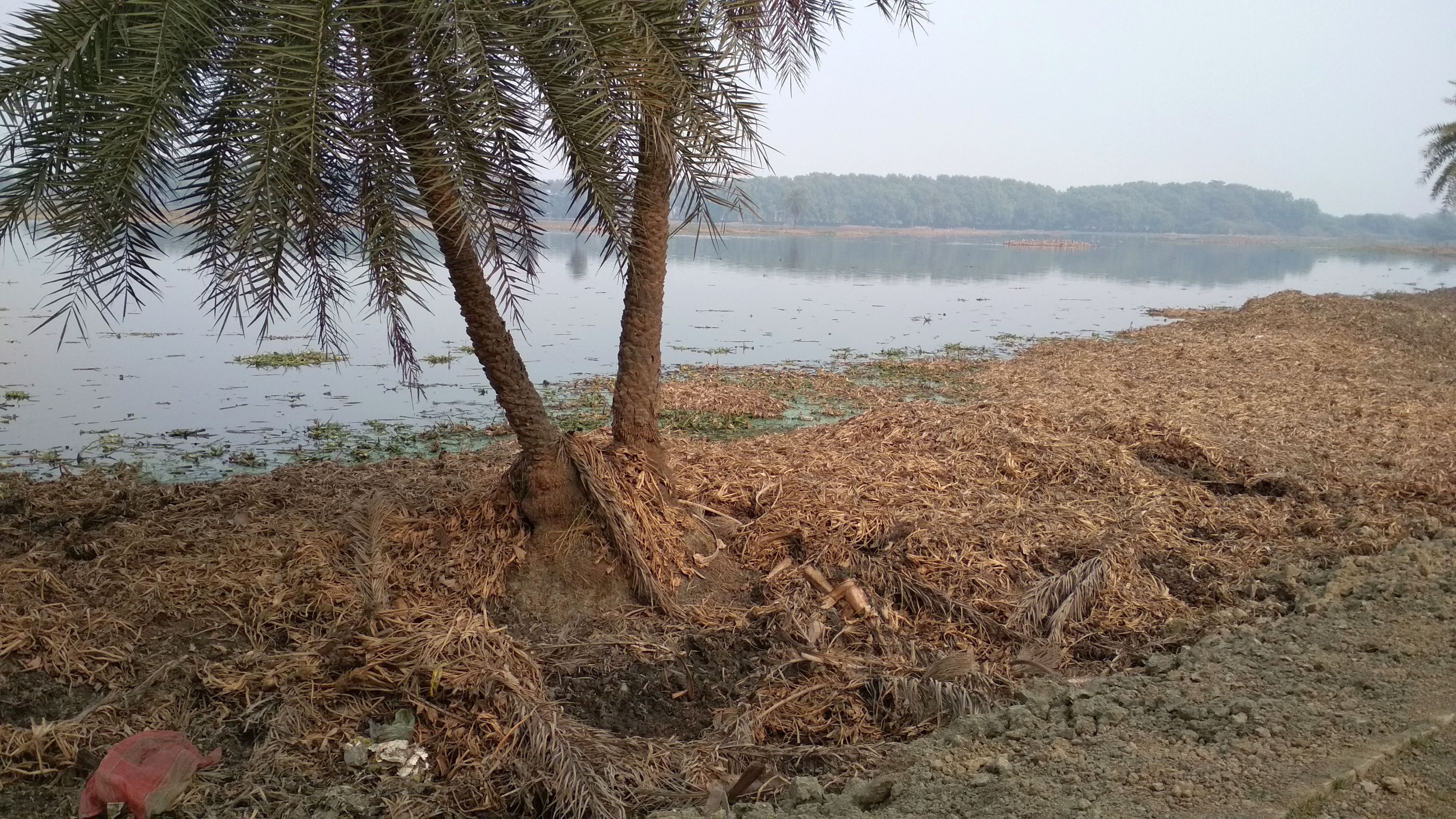
The migratory bird season is in full swing and avid bird watchers have flocked to Surajpur wetland to sight the charismatic Common Teal, Red-crested Pochard, Ferruginous Pochard, Bar-headed Goose, Greylag Goose, Northern Shoveler and Gadwall. It is noon and some birds can be seen resting and preening their feathers in the morning while others are skittish and hide in the tall grasses or in the dense thicket of trees. Some other birds can be seen wading in the shallow waters. One can catch a glimpse of nests teetering on the treetops. The wetland, spread over an area of 308 hectares, lies in a reserve forest area in Gautam Budh Nagar district of Uttar Pradesh. Technically, a wetland is a land area that is saturated with water, either permanently or seasonally and has a distinct ecosystem.
Picnickers throng the wetland alongside habitual visitors like birdwatchers and photography enthusiasts. “In the last few years, the Surajpur wetland has been developed and nature trails established to allow the visitors a glance of the mosaic of habitats—woodland, grassland and marshy area. Mounds have been created for the development of heronry in the water body. The visitor zone around the wetland has been developed with its lawns and pathways,” says Charan Singh, forest guard, Surajpur Reserve Forest.
The creation of embankments and bunds around the wetland ensures the availability of water. The forest department is busy weeding out invasive species of water hyacinth as well as the dense algal growth from the wetland. Singh claims that there has been an increase in the number of migratory birds as well as enriched local biodiversity due to these developments. As per the findings of the recent Asian Waterbird Census (AWC), 2019 a total of 42 resident and 21 migratory bird species were recorded against last year’s total of 35 bird species at Surajpur wetland.
A study by Nasim Ahmad Ansari et al highlights the significant record of avifauna of the Surajpur wetland, Greater Noida, Uttar Pradesh and forms the first record of its kind. The study conducted during March 2010 to February 2013 noted a total of 186 bird species belonging to 44 families. As per the study, the mosaic of habitat types within the wetland serves as an ideal refuge for avifauna.
All this would not have been possible without the untiring efforts of local activists engaged in real-world environmental struggles and politics.

Wetland status to Surajpur
Wildlife, once flourished here, is faced with pressures due to the rapidly urbanising areas nearby, especially various real estate projects, including a sports city. Developments in recent years have tried to reduce the area to a tourist spot rather than maintain it as a natural reserve forest area. An ambitious project by the Uttar Pradesh government in 2014 included Surajpur wetland as a part of a 2000-acre eco-park to develop eco-tourism in Gautam Budh Nagar district. This led to encroachment as well as the felling of nest trees in the wetland.
“In spite of the fact that Surajpur was a part of reserve forest area, no clearances were sought from the union ministry of environment, forest and climate change. Roadway construction, landscaping, contouring and setting up of a parking lot continued. Hundreds of old trees of palm, peepal and neem have been felled and plantation of new trees of alstonia and ficus were done. These ornamental trees do not add much of environmental value, and in fact, adversely impact the natural habitat. Some trees were felled illegally in connivance with forest department employees,” says Vikrant Tongad, founder of Social Action for Environment (SAFE), an NGO set up in 2013 in the area.
SAFE filed a plea in the National Green Tribunal (NGT) objecting to development projects inside the sanctuary following which the NGT, on June 3, 2016, stayed construction inside the wetland and sought reports from the Uttar Pradesh government as well as the Centre on the issue. The forest department was compelled to shelve the eco-park project inside the wetland and forest reserve.
The green lung in Greater Noida was granted the wetland status on September 14, 2018 by the NGT. The petition was filed by SAFE that went on to file several public interest litigations on environmental issues since its inception. The NGT order based on the petition filed in 2016 restricts any construction in the wetland and ruled that all wetland conservation and management rules would be applicable in 60 ha of the low lying area of the 308 ha reserve forest. The legal acknowledgement of the patch as a wetland was a welcome step and locals hoped that the ongoing construction work around the premises of Surajpur would stop.
“Our demand was that the government takes necessary steps to protect the wetland, which plays a pivotal role in groundwater recharge. We have been fighting to stop the misuse of groundwater by private realtors and at the same time to protect the green cover around the wetland,” says Tongad. Hailing from Khedi Bhanauti village that flanks the wetland, Tongad spent his teenage and undergraduate years organising the youth in the area on local issues.

Six more connected wetlands
SAFE, the petitioner moved the tribunal to accord wetland status to six other water bodies that were part of a cascade of wetlands in and around Surajpur. The chain of wetlands has been disturbed by a wall that was erected to protect and fence the reserve forest area of Surajpur. This has been a point of contention with the forest department, which went ahead with constructions that messed up the drainage system in the area. Worried that construction activity would disturb wetlands and impact groundwater recharge in the district, the petitioners took the matter to the NGT. However, the NGT had in its September 14, 2018 order disposed of the plea to declare all six water bodies as wetlands citing lack of revenue record to corroborate the claim.
“This happened even when we placed on record the wetland atlas prepared by Space Application Centre, Indian Space Research Organisation, which mapped around 2,01,503 wetlands in the country. We did this, as there were no revenue records corroborating the fact that other six low lying areas are wetlands,” says Tongad. The Uttar Pradesh government responded to the NGT saying that the six wetlands do not fulfil the criteria of the purported wetland under rule 3 of the Wetlands (Conservation and Management) Rules, 2010 as well as the Wetlands (Conservation and Management) Rules, 2017.
The six low lying areas are also wetlands and they should also be accordingly notified. The conservationists moved the Supreme Court to protect six more wetlands, which on February 20, 2019 issued notices to the Centre and Uttar Pradesh on the plea challenging the NGT’s order refusing to declare Surajpur as wetland. What the court decides remains to be seen.
It is not just Surajpur, wetlands are being encroached upon by private real estate and government in urban landscapes across the country. The wetlands (conservation and management) rules, 2017, notified by the environment ministry, decentralises wetlands management by giving states powers to not only identify and notify wetlands within their jurisdictions but also keep a watch on prohibited activities. The rules have also tried to indirectly widen the ambit of permitted activities by inserting the 'wise use' principle, giving powers to state-level wetland authorities to decide what can be allowed in the larger interest. “This is precarious because states have not had a good track record in conserving and managing wetlands. The new rules also do away with environmental impact assessment that used to be compulsory for taking up any activity on wetlands,” says Tongad.
In this scenario of weakened conservation laws, the task of activists in campaigning and protesting to save wetlands becomes imperative.